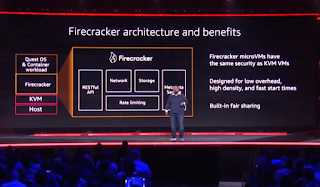AWS re:Invent 2018 kicks off this week in Las Vegas. Once again the event is sold out and seat reservations are required for popular sessions. Here are the highlights from Day 1:

A new AWS Transit Gateway will let enterprises build a hub-and-spoke network topology on AWS infrastructure, enabling the interconnection of existing VPCs, data centers, remote offices, and remote gateways. The customer gets full control over network routing and security. Connected resources and span multiple AWS accounts, including VPCs, Active Directories, and shared services. The new AWS Transit Gateway may also be used to consolidate existing edge connectivity and route it through a single ingress/egress point. Pricing is based on a per-hour rate along with a per-GB data processing fee.

AWS introduced its first cloud instance with up to 100 Gbps of network bandwidth. Use cases are expected to include in-memory caches, data lakes, and other communication-intensive applications. AWS said its new C5n instances incorporate 4th gen custom Nitro hardware. The Elastic Network Interface (ENI) on the C5n uses up to 32 queues (in comparison to 8 on the C5 and C5d), allowing the packet processing workload to be better distributed across all available vCPUs. The ability to push more packets per second will make these instances a great fit for network appliances such as firewalls, routers, and 5G cellular infrastructure. Here are the specs:
 AWS is launching its first cloud instances based on its own Arm-based AWS Graviton Processors. The new processors are the result of the acquisition of Annapurna Labs in 2015. AWS said its Graviton processors are optimized for performance and cost, making them a fit for scale-out workloads where you can share the load across a group of smaller instances. This includes containerized microservices, web servers, development environments, and caching fleets. The new A1 instances are available now in the US East (N. Virginia), US East (Ohio), US West (Oregon), and Europe (Ireland) Regions in On-Demand, Reserved Instance, Spot, Dedicated Instance, and Dedicated Host form.
AWS is launching its first cloud instances based on its own Arm-based AWS Graviton Processors. The new processors are the result of the acquisition of Annapurna Labs in 2015. AWS said its Graviton processors are optimized for performance and cost, making them a fit for scale-out workloads where you can share the load across a group of smaller instances. This includes containerized microservices, web servers, development environments, and caching fleets. The new A1 instances are available now in the US East (N. Virginia), US East (Ohio), US West (Oregon), and Europe (Ireland) Regions in On-Demand, Reserved Instance, Spot, Dedicated Instance, and Dedicated Host form.In addition to processors from strategic partner Intel and its own AWS Graviton processors, AWS is offering cloud instances powered by AMD at a 10% discount.

 AWS introduced Firecracker, a new virtualization technology for #containers -- think microVMs with fast startup times (125ms). The company says Firecracker uses multiple levels of isolation and protection and exposes a minimal attack surface for better security. Firecracker is expected to improve the efficiency of AWS infrastructure. It is also being released as open source. Firecracker is already powering multiple high-volume AWS services including AWS Lambda and AWS Fargate.
AWS introduced Firecracker, a new virtualization technology for #containers -- think microVMs with fast startup times (125ms). The company says Firecracker uses multiple levels of isolation and protection and exposes a minimal attack surface for better security. Firecracker is expected to improve the efficiency of AWS infrastructure. It is also being released as open source. Firecracker is already powering multiple high-volume AWS services including AWS Lambda and AWS Fargate.AWS has developed its own Scalable Reliable Datagram (SRD) protocol for high-performance computing clusters as an alternative to TCP/IP
Epic Games, creator of Fortnite, is running on AWS.
https://reinvent.awsevents.com











